Abstract
Certain dihydroxy bile acids cause secretory diarrhea when present in the colonic lumen at inappropriately high concentrations. However, the mechanism underlying the secretagogue activity has not been fully elucidated. Experiments were performed to test whether mast cells and one of their major mediators, histamine, might contribute to the secretory effect. Chenodeoxycholic acid, a secretory bile acid, and ursodeoxycholic acid, a nonsecretory, hydrophilic bile acid, were compared for their ability to induce chloride secretion across segments of mouse colon mounted in Ussing chambers. Chenodeoxycholic acid, but not ursodeoxycholic acid, induced dose-dependent, biphasic chloride secretion that was greater after serosal than mucosal addition and was greater in distal versus proximal colonic segments. The secretory effect of chenodeoxycholic acid was inhibited by H1 histamine receptor antagonists and modified by the cyclooxygenase inhibitor indomethacin. However, it was unaffected by an H2 histamine receptor antagonist or by atropine. Secretory effects of chenodeoxycholic acid were diminished in magnitude and delayed in colonic tissues from mice with a genetic deficiency of tissue mast cells. Concentrations of chenodeoxycholic acid inducing secretion also released histamine from tissue segments. These data indicate that mast cells and histamine-mediated processes contribute significantly to the secretory effects of dihydroxy bile acids in the murine colon.
Full text
PDF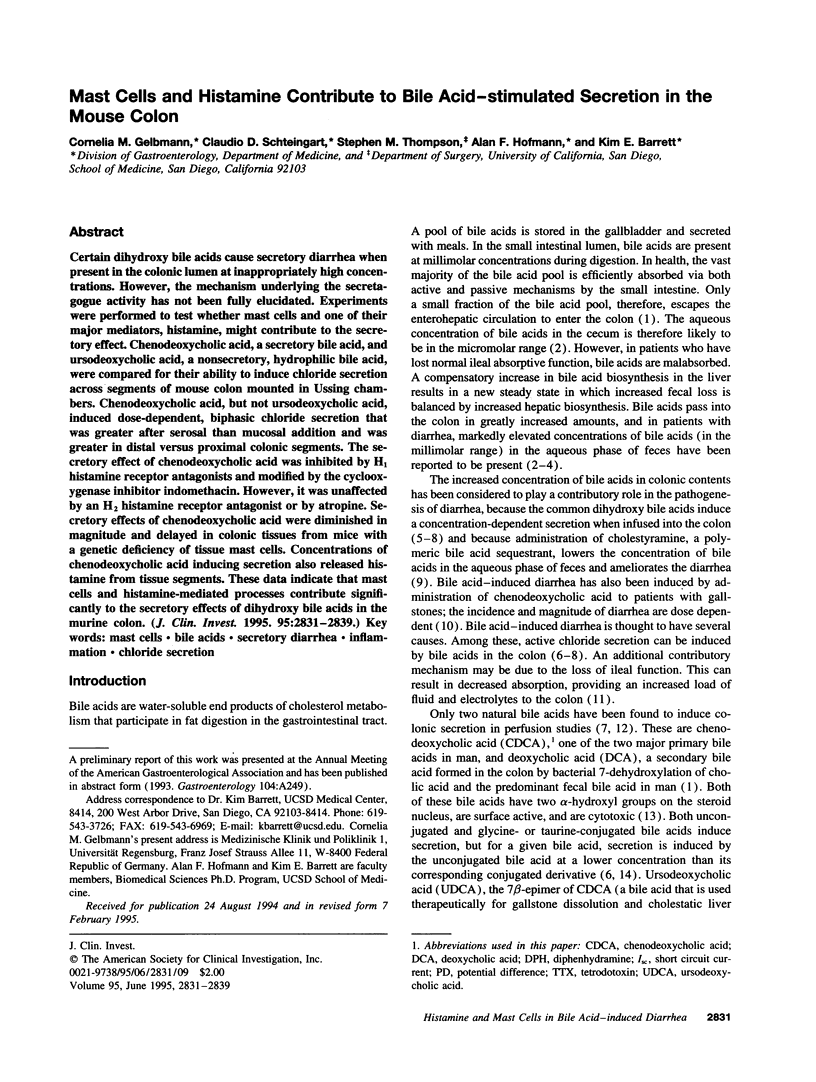
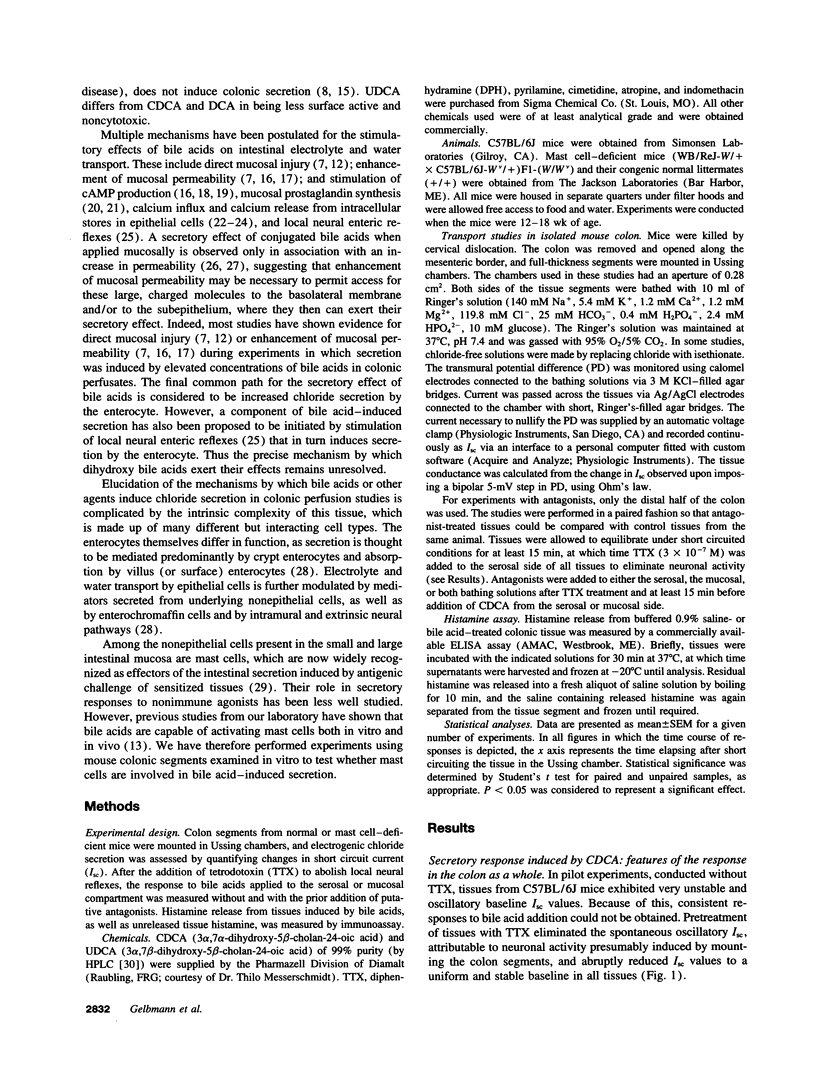

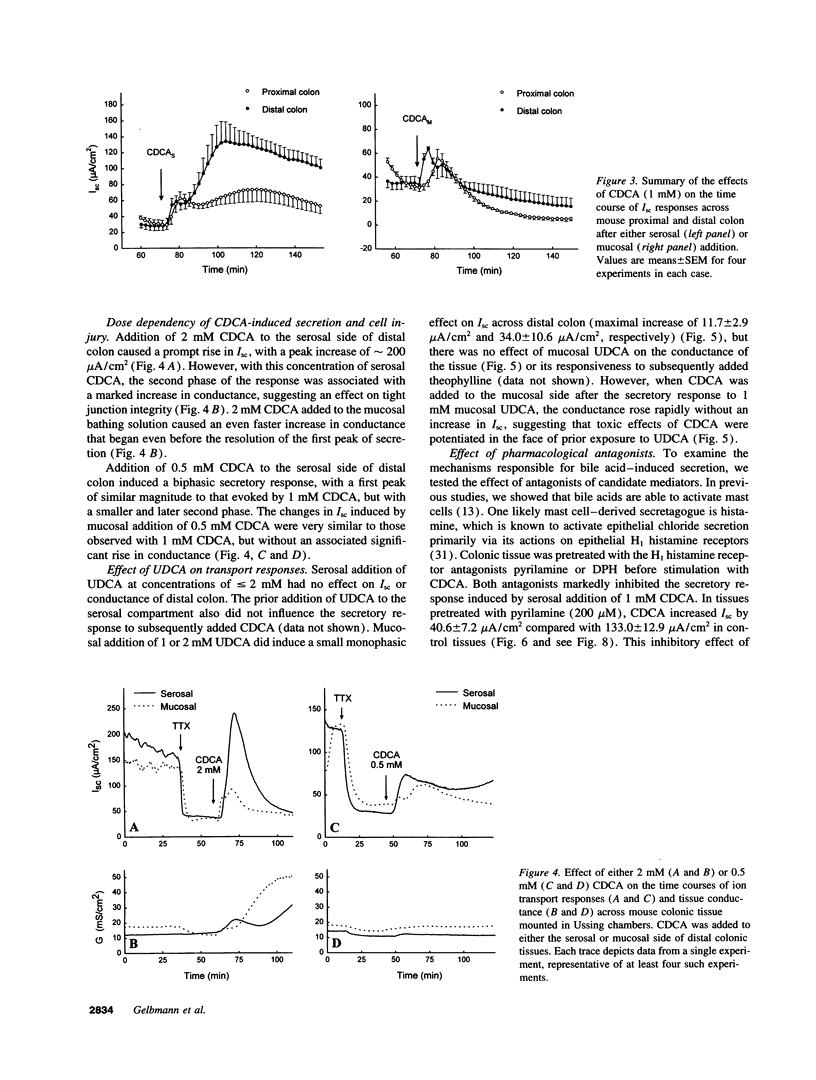
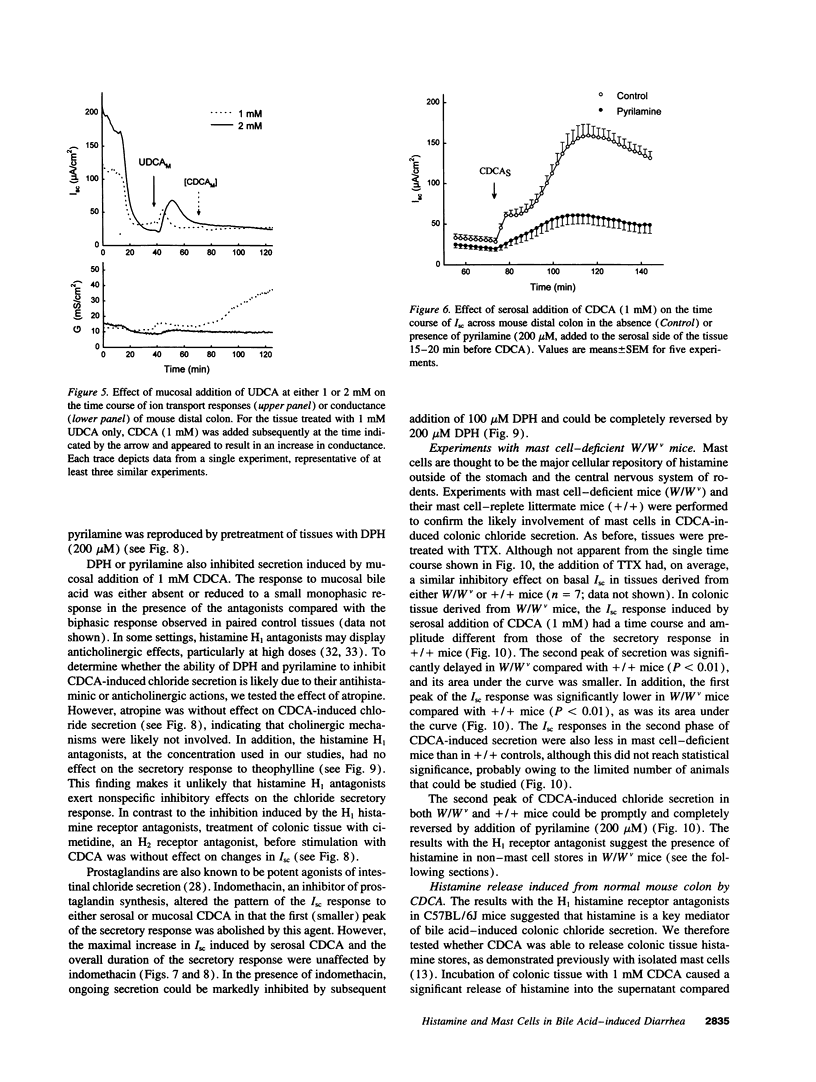
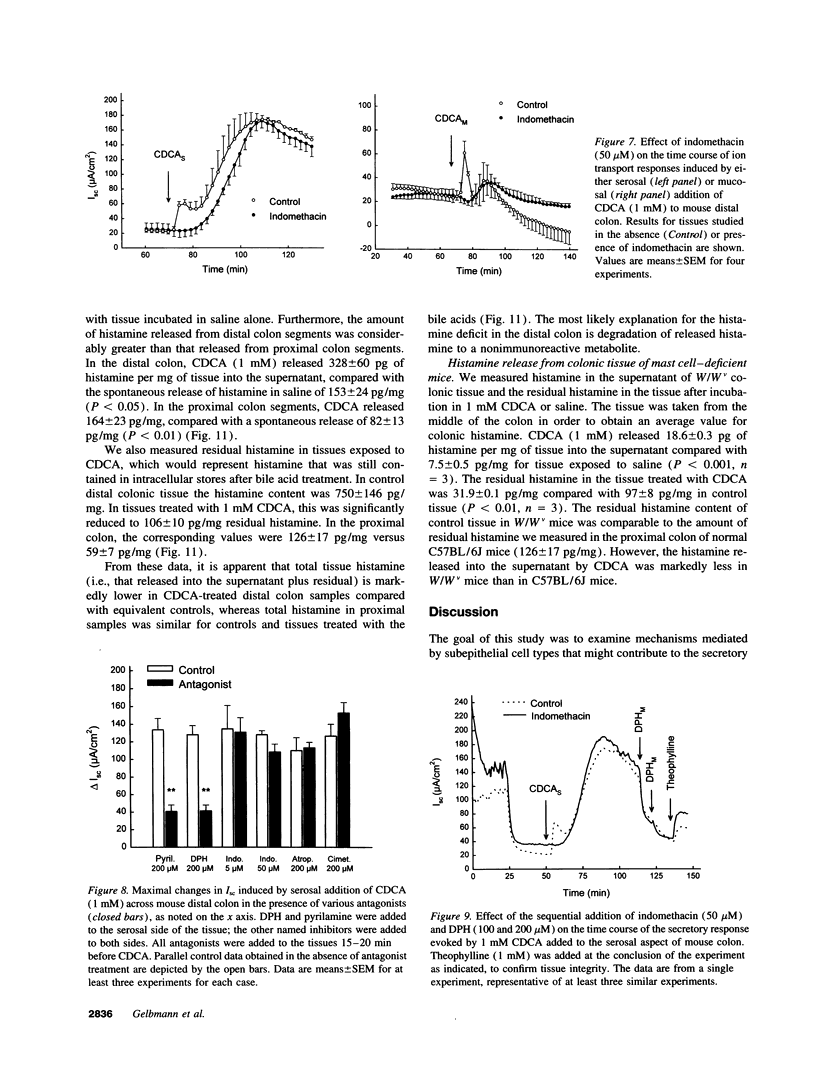
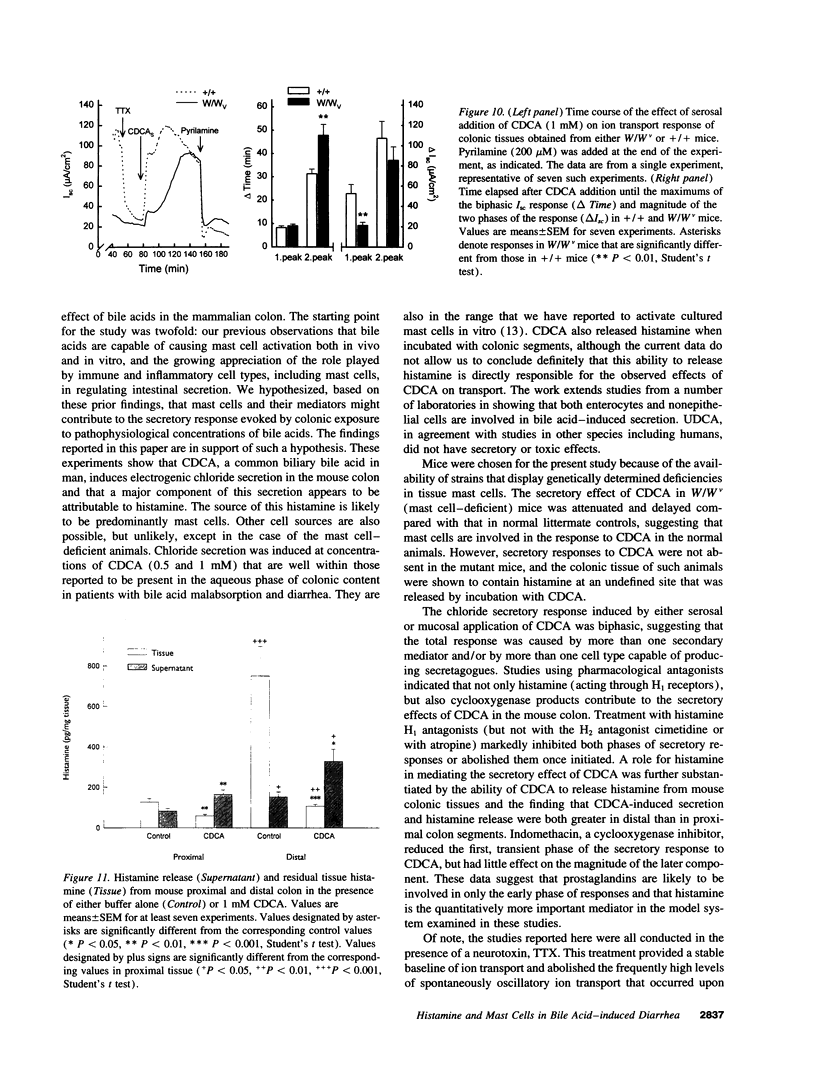
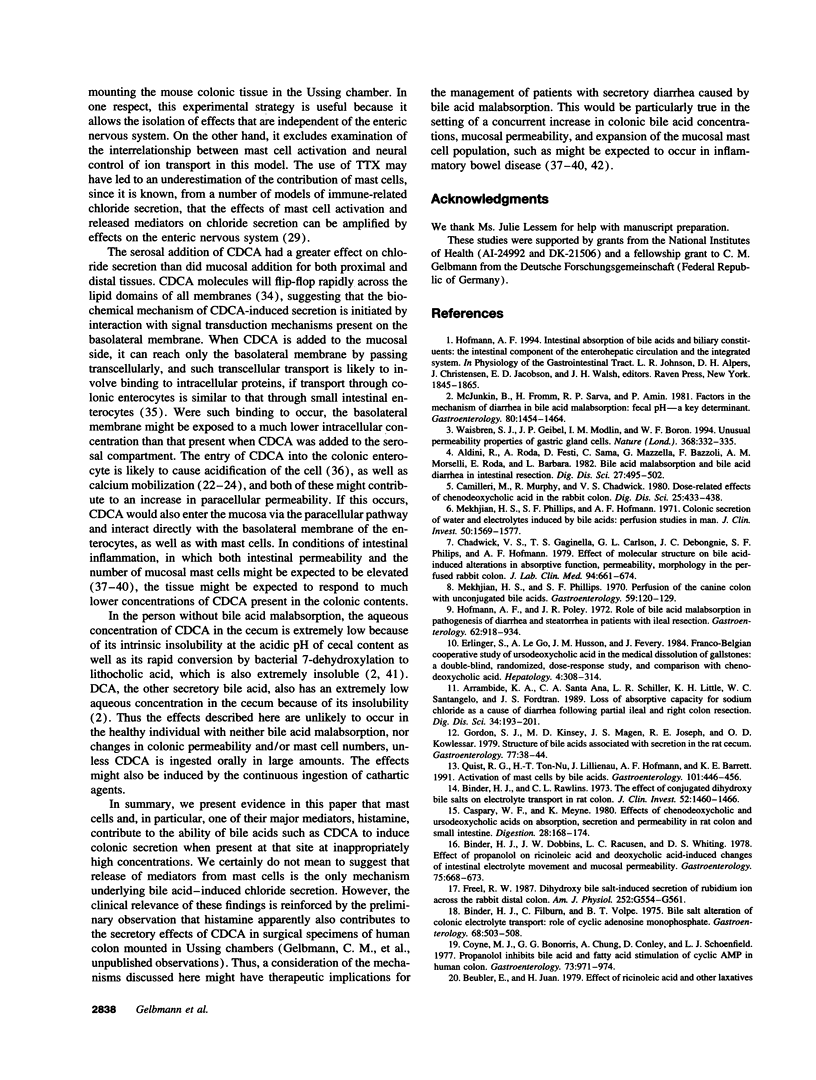
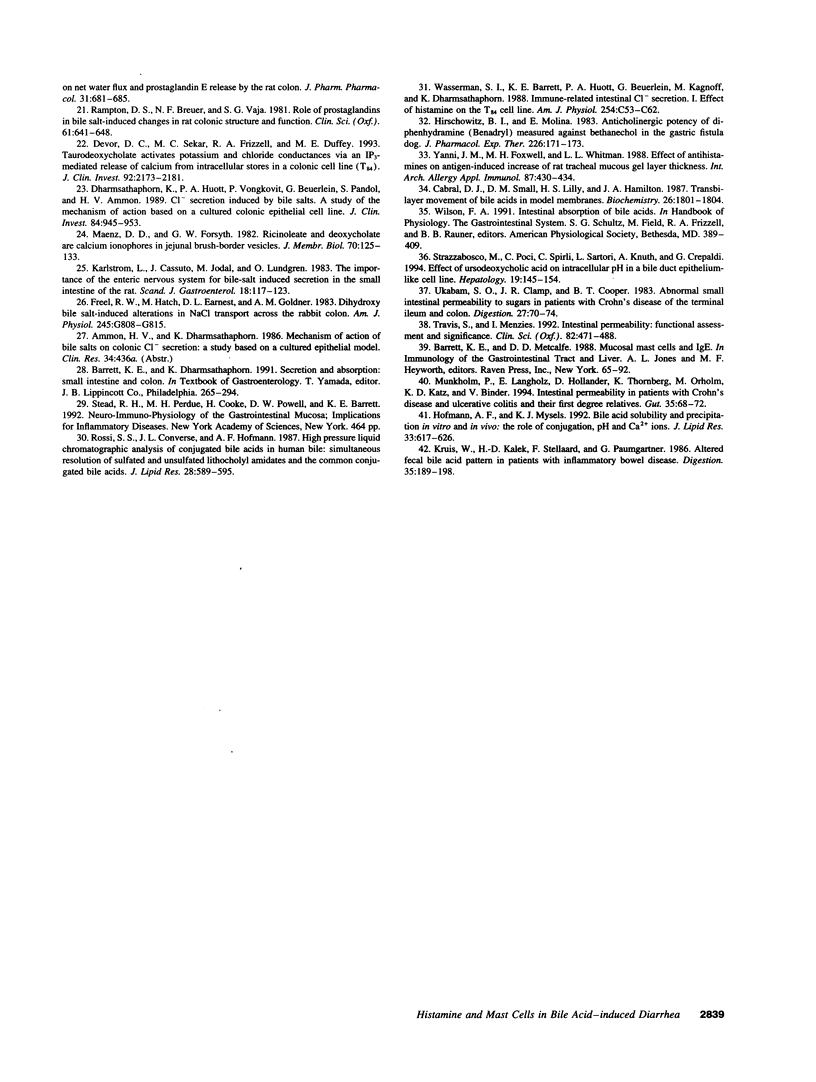
Images in this article
Selected References
These references are in PubMed. This may not be the complete list of references from this article.
- Aldini R., Roda A., Festi D., Sama C., Mazzella G., Bazzoli F., Morselli A. M., Roda E., Barbara L. Bile acid malabsorption and bile acid diarrhea in intestinal resection. Dig Dis Sci. 1982 Jun;27(6):495–502. doi: 10.1007/BF01296727. [DOI] [PubMed] [Google Scholar]
- Arrambide K. A., Santa Ana C. A., Schiller L. R., Little K. H., Santangelo W. C., Fordtran J. S. Loss of absorptive capacity for sodium chloride as a cause of diarrhea following partial ileal and right colon resection. Dig Dis Sci. 1989 Feb;34(2):193–201. doi: 10.1007/BF01536050. [DOI] [PubMed] [Google Scholar]
- Beubler E., Juan H. Effect of ricinoleic acid and other laxatives on net water flux and prostaglandin E release by the rat colon. J Pharm Pharmacol. 1979 Oct;31(10):681–685. doi: 10.1111/j.2042-7158.1979.tb13628.x. [DOI] [PubMed] [Google Scholar]
- Binder H. J., Dobbins J. W., Racusen L. C., Whiting D. S. Effect of propranolol on ricinoleic acid- and deoxycholic acid-induced changes of intestinal electrolyte movement and mucosal permeability. Evidence against the importance of altered permeability in the production of fluid and electrolyte accumulation. Gastroenterology. 1978 Oct;75(4):668–673. [PubMed] [Google Scholar]
- Binder H. J., Filburn C., Volpe B. T. Bile salt alteration of colonic electrolyte transport: role of cyclic adenosine monophosphate. Gastroenterology. 1975 Mar;68(3):503–508. [PubMed] [Google Scholar]
- Binder H. J., Rawlins C. L. Effect of conjugated dihydroxy bile salts on electrolyte transport in rat colon. J Clin Invest. 1973 Jun;52(6):1460–1466. doi: 10.1172/JCI107320. [DOI] [PMC free article] [PubMed] [Google Scholar]
- Cabral D. J., Small D. M., Lilly H. S., Hamilton J. A. Transbilayer movement of bile acids in model membranes. Biochemistry. 1987 Apr 7;26(7):1801–1804. doi: 10.1021/bi00381a002. [DOI] [PubMed] [Google Scholar]
- Camilleri M., Murphy R., Chadwick V. S. Dose-related effects of chenodeoxycholic acid in the rabbit colon. Dig Dis Sci. 1980 Jun;25(6):433–438. doi: 10.1007/BF01395507. [DOI] [PubMed] [Google Scholar]
- Caspary W. F., Meyne K. Effects of chenodeoxy- and ursodeoxycholic acid on absorption, secretion and permeability in rat colon and small intestine. Digestion. 1980;20(3):168–174. doi: 10.1159/000198436. [DOI] [PubMed] [Google Scholar]
- Chadwick V. S., Gaginella T. S., Carlson G. L., Debongnie J. C., Phillips S. F., Hofmann A. F. Effect of molecular structure on bile acid-induced alterations in absorptive function, permeability, and morphology in the perfused rabbit colon. J Lab Clin Med. 1979 Nov;94(5):661–674. [PubMed] [Google Scholar]
- Coyne M. J., Bonorris G. G., Chung A., Conley D., Schoenfield L. J. Propranolol inhibits bile acid and fatty acid stimulation of cyclic AMP in human colon. Gastroenterology. 1977 Nov;73(5):971–974. [PubMed] [Google Scholar]
- Devor D. C., Sekar M. C., Frizzell R. A., Duffey M. E. Taurodeoxycholate activates potassium and chloride conductances via an IP3-mediated release of calcium from intracellular stores in a colonic cell line (T84) J Clin Invest. 1993 Nov;92(5):2173–2181. doi: 10.1172/JCI116819. [DOI] [PMC free article] [PubMed] [Google Scholar]
- Dharmsathaphorn K., Huott P. A., Vongkovit P., Beuerlein G., Pandol S. J., Ammon H. V. Cl- secretion induced by bile salts. A study of the mechanism of action based on a cultured colonic epithelial cell line. J Clin Invest. 1989 Sep;84(3):945–953. doi: 10.1172/JCI114257. [DOI] [PMC free article] [PubMed] [Google Scholar]
- Erlinger S., Le Go A., Husson J. M., Fevery J. Franco-Belgian cooperative study of ursodeoxycholic acid in the medical dissolution of gallstones: a double-blind, randomized, dose-response study, and comparison with chenodeoxycholic acid. Hepatology. 1984 Mar-Apr;4(2):308–314. doi: 10.1002/hep.1840040222. [DOI] [PubMed] [Google Scholar]
- Freel R. W. Dihydroxy bile salt-induced secretion of rubidium ion across the rabbit distal colon. Am J Physiol. 1987 Apr;252(4 Pt 1):G554–G561. doi: 10.1152/ajpgi.1987.252.4.G554. [DOI] [PubMed] [Google Scholar]
- Freel R. W., Hatch M., Earnest D. L., Goldner A. M. Dihydroxy bile salt-induced alterations in NaCl transport across the rabbit colon. Am J Physiol. 1983 Dec;245(6):G808–G815. doi: 10.1152/ajpgi.1983.245.6.G808. [DOI] [PubMed] [Google Scholar]
- Gordon S. J., Kinsey M. D., Magen J. S., Joseph R. E., Kowlessar O. D. Structure of bile acids associated with secretion in the rat cecum. Gastroenterology. 1979 Jul;77(1):38–44. [PubMed] [Google Scholar]
- Hirschowitz B. I., Molina E. Anticholinergic potency of diphenhydramine (Benadryl) measured against bethanechol in the gastric fistula dog. J Pharmacol Exp Ther. 1983 Jul;226(1):171–173. [PubMed] [Google Scholar]
- Hofmann A. F., Mysels K. J. Bile acid solubility and precipitation in vitro and in vivo: the role of conjugation, pH, and Ca2+ ions. J Lipid Res. 1992 May;33(5):617–626. [PubMed] [Google Scholar]
- Hofmann A. F., Poley J. R. Role of bile acid malabsorption in pathogenesis of diarrhea and steatorrhea in patients with ileal resection. I. Response to cholestyramine or replacement of dietary long chain triglyceride by medium chain triglyceride. Gastroenterology. 1972 May;62(5):918–934. [PubMed] [Google Scholar]
- Karlström L., Cassuto J., Jodal M., Lundgren O. The importance of the enteric nervous system for the bile-salt-induced secretion in the small intestine of the rat. Scand J Gastroenterol. 1983 Jan;18(1):117–123. doi: 10.3109/00365528309181570. [DOI] [PubMed] [Google Scholar]
- Kruis W., Kalek H. D., Stellaard F., Paumgartner G. Altered fecal bile acid pattern in patients with inflammatory bowel disease. Digestion. 1986;35(4):189–198. doi: 10.1159/000199367. [DOI] [PubMed] [Google Scholar]
- Maenz D. D., Forsyth G. W. Ricinoleate and deoxycholate are calcium ionophores in jejunal brush border vesicles. J Membr Biol. 1982;70(2):125–133. doi: 10.1007/BF01870222. [DOI] [PubMed] [Google Scholar]
- McJunkin B., Fromm H., Sarva R. P., Amin P. Factors in the mechanism of diarrhea in bile acid malabsorption: fecal pH--a key determinant. Gastroenterology. 1981 Jun;80(6):1454–1464. [PubMed] [Google Scholar]
- Mekhjian H. S., Phillips S. F. Perfusion of the canine colon with unconjugated bile acids. Effect on water and electrolyte transport, morphology, and bile acid absorption. Gastroenterology. 1970 Jul;59(1):120–129. [PubMed] [Google Scholar]
- Mekjian H. S., Phillips S. F., Hofmann A. F. Colonic secretion of water and electrolytes induced by bile acids: perfusion studies in man. J Clin Invest. 1971 Aug;50(8):1569–1577. doi: 10.1172/JCI106644. [DOI] [PMC free article] [PubMed] [Google Scholar]
- Munkholm P., Langholz E., Hollander D., Thornberg K., Orholm M., Katz K. D., Binder V. Intestinal permeability in patients with Crohn's disease and ulcerative colitis and their first degree relatives. Gut. 1994 Jan;35(1):68–72. doi: 10.1136/gut.35.1.68. [DOI] [PMC free article] [PubMed] [Google Scholar]
- Quist R. G., Ton-Nu H. T., Lillienau J., Hofmann A. F., Barrett K. E. Activation of mast cells by bile acids. Gastroenterology. 1991 Aug;101(2):446–456. doi: 10.1016/0016-5085(91)90024-f. [DOI] [PubMed] [Google Scholar]
- Rampton D. S., Breuer N. F., Vaja S. G., Sladen G. E., Dowling R. H. Role of prostaglandins in bile salt-induced changes in rat colonic structure and function. Clin Sci (Lond) 1981 Nov;61(5):641–648. doi: 10.1042/cs0610641. [DOI] [PubMed] [Google Scholar]
- Rossi S. S., Converse J. L., Hofmann A. F. High pressure liquid chromatographic analysis of conjugated bile acids in human bile: simultaneous resolution of sulfated and unsulfated lithocholyl amidates and the common conjugated bile acids. J Lipid Res. 1987 May;28(5):589–595. [PubMed] [Google Scholar]
- Strazzabosco M., Poci C., Spirlí C., Sartori L., Knuth A., Crepaldi G. Effect of ursodeoxycholic acid on intracellular pH in a bile duct epithelium-like cell line. Hepatology. 1994 Jan;19(1):145–154. [PubMed] [Google Scholar]
- Travis S., Menzies I. Intestinal permeability: functional assessment and significance. Clin Sci (Lond) 1992 May;82(5):471–488. doi: 10.1042/cs0820471. [DOI] [PubMed] [Google Scholar]
- Ukabam S. O., Clamp J. R., Cooper B. T. Abnormal small intestinal permeability to sugars in patients with Crohn's disease of the terminal ileum and colon. Digestion. 1983;27(2):70–74. doi: 10.1159/000198932. [DOI] [PubMed] [Google Scholar]
- Waisbren S. J., Geibel J. P., Modlin I. M., Boron W. F. Unusual permeability properties of gastric gland cells. Nature. 1994 Mar 24;368(6469):332–335. doi: 10.1038/368332a0. [DOI] [PubMed] [Google Scholar]
- Wasserman S. I., Barrett K. E., Huott P. A., Beuerlein G., Kagnoff M. F., Dharmsathaphorn K. Immune-related intestinal Cl- secretion. I. Effect of histamine on the T84 cell line. Am J Physiol. 1988 Jan;254(1 Pt 1):C53–C62. doi: 10.1152/ajpcell.1988.254.1.C53. [DOI] [PubMed] [Google Scholar]
- Yanni J. M., Foxwell M. H., Whitman L. L. Effect of antihistamines on antigen-induced increase of rat tracheal mucous gel layer thickness. Int Arch Allergy Appl Immunol. 1988;87(4):430–434. doi: 10.1159/000234714. [DOI] [PubMed] [Google Scholar]



